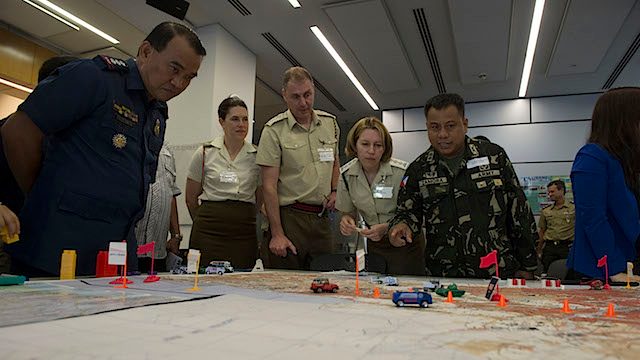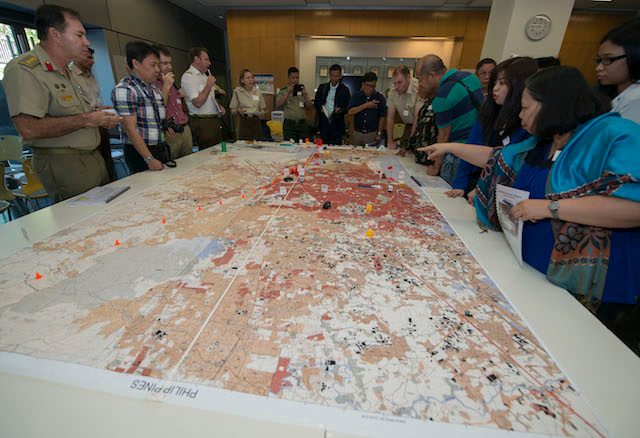SUMMARY
This is AI generated summarization, which may have errors. For context, always refer to the full article.

MANILA, Philippines – They gathered around a big map of Metro Manila – representives of government and non-governmental organizations, including several embassies. At the British embassy on Tuesday, April 28, they simulated their responses in the first 24, 48, and 72 hours of a tremor.
The advice that exercise commander Lieutenant Colonel Jem Blades of the United Kingdom’s Royal Engineers gave them: Metro Manila’s earthquake response should be updated every 6 months.
British troops this week led tabletop exercises on Metro Manila’s earthquake response, a timely activity after the devastation in Nepal that killed at least 5,000.
Blades praised contigency plans presented to them in meetings since last week. The Armed Forces of the Philippines command in Metro Manila, for example, presented how the capital will be divided into 4 quadrants with different government agencies assigned given specific roles and areas of responsibility.
The National Disaster Risk Reduction and Management Council is involved in the exercises. “With the recent turn of events in the country and the region, we really need to step up our efforts to make the Philippines better prepared for earthquakes and other emergencies,” said NDRRMC Executive Director Alexander Pama.
Update every 6 months
Blades said what is important is regular practice of the drills and continous updating of the contingency plans as often as every 6 months.
“People sometimes say, ‘Is the plan perfect?’ It’s never perfect. Once you make the plan perfect, things will change in the future. For example, Manila. You make the plan assuming that the city size is whatever. Six months down the line the city got bigger or smaller. You got a new bridge and the old bridges are gone. There are some new buildings,” Blades told reporters.
“It’s not a static process. Any plan that is being developed, even if it gets to be top-notch, will have to be looked at again 6 months down the line,” he added.

Nepal’s different geology
Lieutenant Colonel Harry Walker, who was part of a previous training exercise in Nepal, expressed confidence that Metro Manila is more resilient to a big earthquake compared to Kathmandu.
He said the geology of Kathmandu was dangerous to an earthquake. “In Kathmandu, it’s slightly different because the Kathmandu valley is on a lake and therefore the geology would be more effective for the buildings to collapse. And then because it’s all flat. Manila is up and down,” Walker said.
The buildings in Metro Manila also appear to be resilient to a big earthquake, particularly the new ones. “The sites being constructed at the minute would appear to be designed for any future earthquake that will hit Manila,” Walker added.
Still, Walker said there are a lot of high-rise buildings in Metro Manila and they should be checked for following the building code. “The fact that one might go will add to a domino effect. But from what we’ve seen here, the structures appear to be well-designed,” he said.
Swapping lessons
Blades and several dozen troops of the 77 Brigade were in Manila for the Philippine-British Exercise Civil Bridge, an activity meant to swap lessons between the two countries.
They met officials of Malacañang, the NDRRMC, and other humanitarian organizations as part of an annual training exercise in different parts of the world. The tabletop exercises culminated their visit and will be the basis of recommendations they’re going to submit to the Philippine government.
“The purpose of the exercise is bringing everyone together, the people we met last week – government departments, the NGOs, the UNOCHA (United Nations Office for the Coordination of Humanitarian Affairs), and then working together understanding how their plans will work together,” said Blades.
Different response organizations need to practice together regularly to make sure there will be no confusion about their roles when a disaster happens, he said.
“Sometimes you find, not in Manila, sometimes in other places, you find that one person has a wonderful plan but it is relying on another person’s plan. But his plan isn’t so wonderful. Part of the thing today is getting them all together and seeing how their plans work together so they can actually be synchronized,” Blades explained.
“I think the big lesson in many places will always be working together. Working out what you’re going to do in advance. having a dry run of what you’re going to do in advance, practising it, perfecting it, and practising it again,” he said.
If responders become victims
One of the realities that may not be anticipated during disaster drills, he added, is the possible need of responders themselves not being able to play their assigned roles because they have to take care of themselves and their family just like everybody else, Blades said.
He said it might mean that disaster response groups inside Metro Manila might be paralyzed and the capital would have to rely on organizations from the outside.
“Where actually are you? Are you at home? At work? At the British embassy? We simulate where we are. At each day we stop and say, ‘Where do you think you’ll be now? What will be happening?'” said Blades.
“We got media involved, too. You might say, ‘We’re following the disaster. We’re putting out messages saying you need to evacuate you need to get water.’ But actually when you look at the exercises, it might become apparent that you won’t be working because perhaps you’ll be out doing things or you’ll be looking out for your family,” Blades said. – Rappler.com
Add a comment
How does this make you feel?
There are no comments yet. Add your comment to start the conversation.